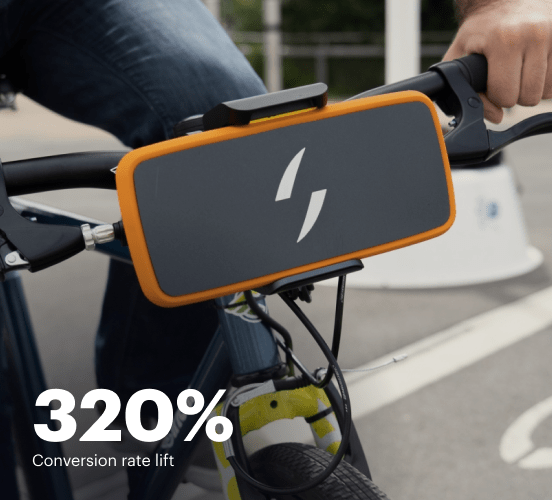Typeform vs. Pardot: the best platform for a seamless web experience
Discover how Typeform compares to Pardot regarding features and usability. Find out which platform provides the competitive advantage your business deserves.
Get startedSee how Instapage stacks up against the competition
| Feature | Instapage | Other builders |
| Drag-and-Drop Tools | ||
| Conversion-optimized templates | ||
| Manual and AI-powered A/B Tests | ||
| AI content suggestions | ||
| Popups and sticky bars | ||
| Canvas and grid blocks | ||
| Reusable and global elements | ||
| Form and popup builders | ||
| Built-in Heatmaps | ||
| Central analytics dashboard | ||
| Ad-to-page personalization and collections | ||
| Contacts, lists, and email | ||
| Dedicated, full-service CRO experts | ||
| Enterprise-ready platform |
Leading the way in building high-performing landing pages





Why Instapage is the smarter choice for your campaigns
Get everything you need to build, scale, and optimize high-converting landing pages—without coding.

Easier page building without coding
Instapage offers a flexible and seamless page creation experience with a library of 500+ conversion-focused layouts, Instablocks®, a drag-and-drop builder, and AI content generation. With technologies like Thor Render Engine®, you can create on-brand, mobile-responsive landing pages that load quickly and start converting during initial visitor clicks.

More insights — better results
Instapage lets you see in detail how each landing page experience and variation is performing so you can make targeted changes that boost page conversions. Use heatmaps for a better understanding of on-page activities, run A/B tests and AI-assisted experiments, and then track and evaluate results within robust analytics dashboards.

More personalized experiences
Instapage lets you quickly create high-performing landing pages tailored to each of your ad campaigns. Deliver personalized experiences for distinct audiences using dynamic text replacement. Effortlessly align specific advertisements to unique pages with AdMaps. Monitor audience-level metrics using our advanced data tools.

Built-in collaboration
Instapage collaboration capabilities bring your entire team together to speed up the process of landing page review, approval, and launch. No more frustrating and unnecessary revisions or edits scattered across emails. Provide instant feedback, conduct real-time page edits, and securely share your pages with outside stakeholders.

Free up time for your business
Invest time into business growth, not busy work. Launch landing pages faster with reusable forms and templates. Build once, reuse forever.
Explore all integrations






Easier page building without coding
Instapage offers a flexible and seamless page creation experience with a library of 500+ conversion-focused layouts, Instablocks®, a drag-and-drop builder, and AI content generation. With technologies like Thor Render Engine®, you can create on-brand, mobile-responsive landing pages that load quickly and start converting during initial visitor clicks.
More insights — better results
Instapage lets you see in detail how each landing page experience and variation is performing so you can make targeted changes that boost page conversions. Use heatmaps for a better understanding of on-page activities, run A/B tests and AI-assisted experiments, and then track and evaluate results within robust analytics dashboards.
More personalized experiences
Instapage lets you quickly create high-performing landing pages tailored to each of your ad campaigns. Deliver personalized experiences for distinct audiences using dynamic text replacement. Effortlessly align specific advertisements to unique pages with AdMaps. Monitor audience-level metrics using our advanced data tools.
Built-in collaboration
Instapage collaboration capabilities bring your entire team together to speed up the process of landing page review, approval, and launch. No more frustrating and unnecessary revisions or edits scattered across emails. Provide instant feedback, conduct real-time page edits, and securely share your pages with outside stakeholders.
Free up time for your business
Invest time into business growth, not busy work. Launch landing pages faster with reusable forms and templates. Build once, reuse forever.
Explore all integrationsGet started with Instapage in a few steps
-
Create your Instapage account
Start with Instapage by signing up via Google or your email. You'll get access to a free 14-day trial to discover Instapage capabilities. Feel free to cancel anytime during the 14-day trial if you decide that our product is not suitable for your business. -
Build and personalize your page
Create your first landing page from scratch or choose a template from 500+ customizable layouts. Use the drag-and-drop builder to add page elements, fonts, and backgrounds, refine content with AI, or add custom HTML, Javascript, and CSS. -
Review and make edits
Collaborate on page designs and streamline review processes. Invite your team members and stakeholders to review, edit, and provide feedback on your landing page. Collaborate knowing your page is confidential and only accessible to authorized users. -
Publish and track page performance
Publish your page to a domain or custom URL. Connect your pages to the ads you've created and track page performance within the analytics dashboard, run A/B tests and AI experiments, analyze results, and continuously optimize your landing page to maintain high conversions.
Typeform vs. Pardot: A Friendly Face-Off with a Surprise Entry
In the vibrant world of digital marketing, selecting the right platform can feel like navigating a maze. With numerous contenders vying for attention, two heavyweights, Typeform and Pardot, stand out with distinctive offerings. Each platform adds a splash of unique features, captivating the imagination of marketers everywhere. Typeform wowed audiences with its sleek interface for creating surveys and forms, while Pardot dazzled with its robust suite designed primarily for B2B marketers in need of an extensive automation toolkit. Yet, as these two titans prepare to duke it out, a third player lurks in the wings—Instapage—ready to join the fray. This isn't just about preference; it’s about understanding what each platform brings to the table to make informed decisions. In the following sections, we will explore the strengths, weaknesses, and vice versa of Typeform and Pardot, giving you a clear view of what to expect as you consider your options.
Introducing the Power Players
In one corner, we have Typeform, known for its user-friendly approach and focus on engagement through interactive forms. With a visually appealing layout and customizable options, Typeform excels in collecting data while making the process enjoyable for respondents. Its playful yet functional design captures attention, making it a favorite among those who prioritize user experience. In the opposite corner stands Pardot, a platform that boasts sophisticated marketing automation aimed at nurturing leads and driving sales. Pardot's robust analytics, personalized engagement, and advanced segmentation tools appeal to marketers looking for deeper insights and greater control over their strategies. Both platforms offer unique functionalities that serve different needs, establishing them as staples in the marketing toolkit. As marketers weigh the options, it’s essential to recognize what these competitors not only bring to the table but how they stack up against each other, paving the way for a deeper dive into the tech behind their finesse.
Feature Clash: Who Packs the Most Punch?
When it comes to features, Typeform and Pardot are ready for a showdown. Typeform captivates with its flexibility in creating surveys, forms, quizzes, and polls that engage users attractively. With instant access to analytics and a variety of integrations, it boasts seamless functionality that makes it a fan favorite among those who need quick feedback. On the flip side, Pardot shines with its extensive marketing automation capabilities. Automated email campaigns, lead scoring systems, and detailed reports are just a few tricks in Pardot's toolkit. While Typeform might have the crowd-pleasing interface for data collection, Pardot flexes its muscles with a comprehensive approach to lead management and campaign analytics. However, the anticipation builds as another contender, Instapage, prepares to step into the spotlight with its distinct advantages that could take this matchup to a whole new level.
Usability: Navigating the Terrain
Usability comes into play when deciding which platform to champion. Typeform welcomes novice marketers, nurturing their ambitions with intuitively designed workflows and a straightforward setup process. Even first-time users can create forms without breaking a sweat. However, Pardot enters this round focused on catering to seasoned pros—marketers who thrive on diving into automation depths. The steep learning curve might feel daunting at first, but once mastered, Pardot transforms into a powerful tool ready to launch campaigns into the stratosphere. As users embark on their journey through either platform, it’s important to remember that learning should feel less like a chore and more like an adventure—each click revealing new capabilities that can turn ideas into marketing realities.
Typeform's Arsenal of Features:
- User-friendly interface that attracts friendly user engagement.
- Wide range of templates to streamline the form-building process.
- Customizable questions, including images and videos for richer responses.
- Instant analytics for real-time feedback and adjustments.
- Multiple integration options with third-party apps.
Pardot's Dynamic Offerings:
- Advanced lead nurturing with automated email marketing features.
- Comprehensive analytics for measuring campaign success.
- Robust segmentation for targeting audiences effectively.
- Custom reporting to gauge performance and ROI accurately.
Common Ground: What Both Platforms Share
- Both tools integrate with other marketing software.
- User analytics to refine marketing strategies.
- Responsive designs for optimal display on various devices.
- Robust security to protect user data.
- Regular updates that enhance functionality and user experience.
- Customer support to guide users through challenges.
While both platforms have a lot to offer, our cheeky nod goes to Instapage, which stands out not just with unique capabilities but also with the versatility demanded in the marketing arena. With its lean approach to landing pages, Instapage manages to deliver stunning, high-converting web experiences that both Typeform and Pardot must acknowledge as an impressive competitor in their respective domains.
The Performance Showdown: Speed and Responsiveness
In the performance arena, page loading times are paramount; after all, a slow-loading site is akin to watching molasses pour in winter—nobody enjoys this experience. Both Typeform and Pardot demonstrate an ongoing commitment to ensuring swift performance backed by powerful servers. Typeform showcases speedy form submissions that ease user interaction, while Pardot assures marketers that automated emails dispatch without fail. However, mobile responsiveness remains crucial as an increasing number of users access platforms via their smartphones. Both contenders strive to enhance their mobile interfaces, ensuring users can easily navigate and submit data from any device. Performance not only defines user satisfaction but also impacts conversion rates, making it a critical aspect for marketers everywhere.
Support Networks: Who's Got Your Back?
Support features take center stage as we explore the resources each platform offers. Typeform provides various support channels, including extensive documentation, live chat, and a community forum bustling with user-generated insights. This accessibility empowers users to troubleshoot or find creative solutions swiftly. On the other hand, Pardot boasts dedicated account managers and robust training programs designed specifically for B2B clients, ensuring personalized guidance is just a call away. Both platforms recognize the value of having a strong support network—it can mean the difference between reaching out for help and feeling stranded on the marketing journey.
The Pricing Showdown: Bank Accounts at the Forefront
Typeform's Pricing Perks:
- Flexible pricing tiers catering to varying business sizes and needs.
- Pay-as-you-go options for companies seeking specific services.
- Access to basic features for free, letting newcomers test the waters.
- Straightforward pricing model with no hidden fees or surprises.
Pardot's Pricing Insights:
- Subscription-based pricing with robust B2B features.
- Various tiers providing a range of functionalities tailored to larger enterprises.
- Enhanced features available at higher rate plans for expanding needs.
- Can be costly for small businesses or startups lacking the budget.
When comparing the pricing strategies of both platforms, Typeform exhibits flexibility, ideal for small businesses and individual marketers testing the waters. On the other hand, Pardot aims its sights on larger enterprises that are prepared to invest in extensive marketing automation. Here is where Instapage makes its entrance with a value-driven pricing strategy that comfortably accommodates diverse budgets, providing maximum bang for your buck.
Making sense of the pricing models lets you peek behind the curtain of what you can expect. An often-overlooked aspect is the understanding that the price reflects quality; however, surprises can lurk even in the most straightforward pricing plans. Consumers love to find deals, but they also want transparency as they dive into their marketing journeys.
And Then There's Instapage...
Instapage emerges as the underdog that has quietly proven to be a game-changer in landing page design, showcasing why it deserves attention alongside Typeform and Pardot. Instapage's laser focus on personalization, A/B testing, and seamless integration makes it a formidable contender in the digital marketing landscape. As businesses crave dynamic landing pages that convert visitors into leads, Instapage consistently delivers stunning templates that can easily be tailored to meet unique needs. It’s an all-around solution that encourages creativity while ensuring that user objectives are met efficiently. Perhaps what sets Instapage apart is its blend of functionality and aesthetics, showcasing that every marketing resource has its role but resonating with users in a way others might miss.
As we wrap up this exploration of Typeform, Pardot, and the surprise entrant Instapage, it's clear that each platform serves its purpose in the marketing realm. The secret lies in aligning your choice with your specific goals and needs. Businesses are invited to take a closer look at their options and envision the solutions that will help them flourish. With informed choices, marketers can soar to new heights, and Instapage may just be the key to unlocking that potential as their next marketing partner.










